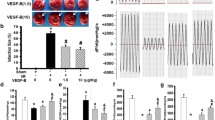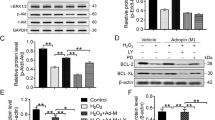Abstract
Several studies have identified the critical role of calcium-sensing receptors (CaSRs) in cardiac ischaemia/reperfusion injury and cardiac hypertrophy and have demonstrated that CaSRs induce myocardial apoptosis by activating MAPKs. Using acute myocardial infarction rat models, we found that a combination therapy of CaSR inhibition and embryonic stem cell (ESC) transplantation after acute myocardial infarction (AMI) leads to a dramatic reduction in the infarct size; a significant increase in the maximum rising and falling rate (+dp/dtmax and −dp/dtmax, respectively) of left ventricular pressure; a significant decrease in left ventricular end-diastolic pressure; a significant decrease in the mRNA expression level of CaSR, Bax, Bcl-2, cleaved caspase-3, cleaved caspase-9, p-ERK, p-JNK and p-P38 protein together with apoptosis indexes in the C and E groups; and a significant decrease in cTnT levels as well as LDH and CK activity. These findings indicate that cardiac function could be enhanced significantly by combination therapy with CaSR inhibition and ESC transplantation; the effect was better than ESC transplantation alone, and the mechanism might be associated with a reduction in cell apoptosis via the inhibition of the MAPK pathway. Apoptosis could be reduced through CaSR, which regulates the MAPK pathway and apoptosis-related protein. Our study indicated that CaSR inhibitors have a pivotal role in the treatment of AMI.







Similar content being viewed by others
References
Chen YL, Sun CK, Tsai TH, Chang LT, Leu S, Zhen YY, Sheu JJ, Chua S, Yeh KH, Lu HI, Chang HW, Lee FY, Yip HK (2015) Adipose-derived mesenchymal stem cells embedded in platelet-rich fibrin scaffolds promote angiogenesis, preserve heart function, and reduce left ventricular remodeling in rat acute myocardial infarction. Am J Transl Res 7(5):781
Min JY, Huang X, Xiang M, Meissner A, Chen Y, Ke Q, Kaplan E, Rana JS, Oettgen P, Morgan JP (2006) Homing of intravenously infused embryonic stem cell-derived cells to injured hearts after myocardial infarction. J Thorac Cardiovasc Surg 131(4):889–897
Zhang GW, Gu TX, Guan XY, Sun XJ, Qi X, Li XY, Wang XB, Yu L, Jiang DQ, Tang R, Li-Ling J (2015) bFGF binding cardiac extracellular matrix promotes the repair potential of bone marrow mesenchymal stem cells in a rabbit model for acute myocardial infarction. Biomed Mater 10(6):065018
Lee HW, Lee HC, Park JH, Kim BW, Ahn J, Kim JH, Park JS, Oh JH, Choi JH, Cha KS, Hong TJ, Park TS, Kim SP, Song S, Kim JY, Park MH, Jung JS (2015) Effects of intracoronary administration of autologous adipose tissue-derived stem cells on acute myocardialinfarction in a porcine model. Yonsei Med J 56(6):1522–1529
Freund C, Mummery CL (2009) Prospects for pluripotent stem cell-derived cardiomyocytes in cardiac cell therapy and as disease models. J Cell Biochem 107(4):592–599
Vallée JP, Hauwel M, Lepetit-Coiffé M, Bei W, Montet-Abou K, Meda P, Gardier S, Zammaretti P, Kraehenbuehl TP, Herrmann F, Hubbell JA, Jaconi ME (2013) Embryonic stem cell-based cardiopatches improve cardiac function in infarcted rats. Stem Cells Transl Med 1(3):248–260
Sun YH, Liu MN, Li H, Shi S, Zhao YJ, Wang R, Xu CQ (2006) Calcium-sensing receptor induces rat neonatal ventricular cardiomyocyte apoptosis. Biochem Biophys Res Commun 350(4):942–948
Wang LN, Wang C, Lin Y, Xi YH, Zhang WH, Zhao YJ, Li HZ, Tian Y, Lv YJ, Yang BF, Xu CQ (2008) Involvement of calcium-sensing receptor in cardiachypertrophy-induced by angiotensin II through calcineurin pathway in cultured neonatal rat cardiomyocytes. Biochem Biophys Res Commun 369(2):584–589
Lu FH, Fu SB, Leng X, Zhang X, Dong S, Zhao YJ, Ren H, Li H, Zhong X, Xu CQ, Zhang WH (2013) Role of the calcium-sensing receptor in cardiomyocyte apoptosis via the sarcoplasmic reticulum and mitochondrial death pathway in cardiac hypertrophy and heart failure. Cell Physiol Biochem 31(4–5):728–743
Chou SH, Lin SZ, Kuo WW, Pai P, Lin JY, Lai CH, Kuo CH, Lin KH, Tsai FJ, Huang CY (2014) Mesenchymal stem cell insights: prospects in cardiovascular therapy. Cell Transplant 23(4–5):513–529
Su W, Leng L, Han Z, He Z, Li Z (2013) Bioluminescence imaging of human embryonic stem cell-derived endothelial cells fortreatment of myocardial infarction. Methods Mol Biol 1052:203–215
Huber BC, Ransohoff JD, Ransohoff KJ, Riegler J, Ebert A, Kodo K, Gong Y, Sanchez-Freire V, Dey D, Kooreman NG, Diecke S, Zhang WY, Odegaard J, Hu S, Gold JD, Robbins RC, Wu JC (2013) Costimulation-adhesion blockade is superior to cyclosporine A and prednisone immunosuppressive therapyfor preventing rejection of differentiated human embryonic stem cells following transplantation. Stem Cells 31(11):2354–2363
Chedrawy EG, Wang JS, Nguyen DM, Shum-Tim D, Chiu RC (2002) Incorporation and integration of implanted myogenic and stem cells into native myocardial fibers :anatomic basis for functional improvement. J Thora Cardiovas Surg 124(3):584–590
Moon SH, Kang SW, Park SJ, Bae D, Kim SJ, Lee HA, Kim KS, Hong KS, Kim JS, Do JT, Byun KH, Chung HM (2013) The use of aggregates of purified cardiomyocytes derived from human ESCs for functional engraftment aftermyocardial infarction. Biomaterials 34(16):4013–4026
Guo J, Li HZ, Wang LC, Zhang WH, Li GW, Xing WJ, Wang R, Xu CQ (2012) Increased expression of calcium-sensing receptors in atherosclerosis confers hypersensitivity to acutemyocardial infarction in rats. Mol Cell Biochem 366(1–2):345–354
Moll UM, Zaika A (2001) Nuclear and mitochondrial apoptotic pathways of p53. FEBS Lett 493(2–3):65–69
Mummery C, Ward-van Oostwaard D, Doevendans P, Spijker R, van den Brink S, Hassink R, van der Heyden M, Opthof T, Pera M, de la Riviere AB, Passier R, Tertoolen L (2003) Differentiation of human embryonic stem cells to cardiomyocytes: role of coculture with visceral endoderm-likecells. Circulation 107(21):2733–2740
Kuethe F, Figulla HR, Voth M, Richartz BM, Opfermann T, Sayer HG, Krack A, Fritzenwanger M, Höffken K, Gottschild D, Werner GS (2004) Mobilization of stem cells by granulocyte colony-stimulating factor for the regeneration of myocardial tissue after myocardial infarction. Dtsch Med Wochenschr 129(9):424–428
Li X, Wang YN, Jin ZY (2015) Molecular imaging of stem cells for the treatment of acute myocardial infarction. Int J Clin Exp Med 15;8(6):8938–8947
Acknowledgements
This work was supported by the National Natural Science Foundation of China (No. 81300163, 81200160).
Author information
Authors and Affiliations
Corresponding author
Rights and permissions
About this article
Cite this article
Sun, J., Wei, T., Bai, S. et al. Calcium-sensing receptor-mediated mitogen-activated protein kinase pathway improves the status of transplanted mouse embryonic stem cells in rats with acute myocardial infarction. Mol Cell Biochem 431, 151–160 (2017). https://doi.org/10.1007/s11010-017-2987-z
Received:
Accepted:
Published:
Issue Date:
DOI: https://doi.org/10.1007/s11010-017-2987-z




